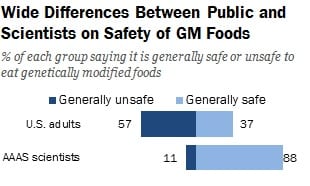By: Patrick Griffin, Athens Science Café
A couple of weeks ago, as I walked through the charming town of Broad Ripple, Indiana, I stumbled upon a behemoth three-story Chipotle. Recently erected to satiate the growing popularity of the Mexican-themed grill, the building was sporting a sign that piqued my interest as a scientist and consumer. In white letters surrounded by the company's trademark burnt-red, the sign read “GMO NO MORE!†I rolled my eyes, concerned about the message being sent.
Chipotle's decision not to use genetically modified organisms (GMO) in their food seems to the average walker-by like an informed decision, one that condemns GM food as dangerous and not ideal for consumption. “They say these ingredients are safe, but I think we all know we’d rather have food that doesn’t contain them,” said Steve Ells, Founder and CEO of Chipotle, in an interview with CNNMoney. However, the outcry from the scientific community would suggest otherwise and many have claimed that this is a savvy marketing ploy, designed to prey on a consumer's ignorance of what a GMO is. The opposition claims these scientists are being deceitful, funded by Monsanto to spread lies about the science that very few below the Ivory Tower understand—à la Aaron Eckhart in “Thank You For Smokingâ€. Personally, this conversation makes me sad, yet another failure of communication between the informed expert and the understandably concerned consumer. Why is there such a large gap between laymen and the scientist? Where is the cause for concern in eating GMO food? What are the facts?
 Survey of US adults 8/15; Survey AAAS Scientists 10/14. PEW Research Center.
Survey of US adults 8/15; Survey AAAS Scientists 10/14. PEW Research Center.
For over 12,000 years, genetic modification of plants and animals through selective breeding has been taking place in one form or another. Often, this process took generations to produce the desired outcome— larger livestock, sweeter fruit, a healthier harvest. Today, scientists have the ability to target with surgical precision the DNA of the “trait†that they desire and implant it into a different organism. A process that used to take decade now takes only months. In a sense, every time someone says “GMO†what they really are referring to is a “transgenic†organism—one that has had a DNA sequence inserted into it by modern biotechnology techniques. Sounds creepy right? Maybe you think so, however, this process is not exactly the alchemy of Dr. Frankenstein. There is a Gene Wilder pun here but I will spare you. It is important to understand that random mutation occurs throughout all species all the time, invariably producing new proteins or altering expression of pre-existing genes. If a plant population has the evolutionary “need†to become herbicide resistant, be assured it probably will (see superweeds), and while the mechanism of that resistance would likely not be the same as a pre-existing herbicide resistance in a bacteria, the effect would not be fundamentally different (i.e. a herbicide resistant plant). Taking a trait found in one organism and inserting it into another is not unnatural or grotesque; it is a timesaving technique developed by smart people to bypasses the time consuming process of selective breeding. The insertion of genes into new organisms with modern biotechnology science is only unique in its expediency and selectivity.
Given a little time and a point in the right direction, I think the average consumer can understand the risks GMO foods could pose to their health. Yes, irate crop scientist, there are risks. In 2003, The Society of Toxicology produced an exhaustive review (1) of the potential of GMO food to be harmful. For instance, they first asked— Can the transgenic-DNA incorporate into the genome of the consumer? This is a softball; we eat DNA everyday! Literally, every food we consume has DNA, and transgenic DNA is not fundamentally different—broken down by digestive enzymes and not able to incorporate itself into our genetic sequence. Can the product of the transgene be harmful? More complicated. Two areas of concern are present whenever a new GMO is created. First, the transgene could produce a toxic chemical. Luckily, the EPA already has strict methods for conducting toxicology testing that apply to each transgenic organism produced. Each new transgene does need to be tested, but the threat of a transgenic food containing a toxic substance is not different than the same threat in “non-GMO†food that is introduced to the market. Second, the transgene could produce a protein that is particularly allergenic, a real threat that occurred most notably when a Brazil nut protein was incorporated into soybean to increase their nutrition (2). The ability to predict allergenic potential is a vexing problem, one that is addressed through examining the stability of proteins under stress and testing broken-down proteins for high reactivity with human antibodies. Once again, this threat is not unique to transgenes and needs to be addressed whenever bringing any new product to market.
Other questions raised include: Can antibiotic resistance lead to gut-microbe resistance? Will transgenes reduce the nutritional value of the food? Will transgenic food negatively affect non-target organisms? While they found no evidence for GMO technology contributing to antibiotic resistance in gut-microbes nor did they find that GMO technology decreased the nutritional value of the product, there are legitimate concerns about the ecological impact that GMO crops are having on their environment. From the rise of superweeds to the declining monarch butterfly population (3), GMO science is not without its negative externalities that need addressing. To their credit, Chipotle even cites on their website the ecological impact of GMOs as a reason for discontinuing their use. Bravo. Other areas of concern include the safety of pesticides and herbicides sprayed on GMO crops. Once again, an important issue that needs addressing, however, just because a plant is non-GMO does not mean it is not sprayed with similar chemicals. Is concern for these nuanced and complicated issues really what they mean to convey by a large, proud sign in the window of their store? Could Chipotle's decision really be inspired by their love of beautiful insects and disdain for hard-to-kill shrubs? I think not. What the average consumer must think is exactly what I thought when I saw the “GMO NO MORE!†sign in Broad Ripple, Indiana—GMOs must be bad for me. In other words: “We don't use that poison, come eat at Chipotle.â€
Ultimately, The Society of Toxicology concluded that, “The level of safety of current [Biotechnology Derived] foods to consumers appears to be equivalent to that of traditional foods.†This endorsement has been echoed by the American Medical Association, The US National Academy of Sciences, The British Royal Society, and The World Health Organization. How, then, can Chipotle challenge the authority of such reputable organizations? The truth is, they can't and truly don't try. Of the reasons they offer for the pulling GMOs, they only state that the long-term impacts of GMO foods are still being studied—a thinly veiled aphorism that means “We think they are bad for you but we have no proof yetâ€. The sad truth is that only 37% of Americans think that GMOs are safe to eat and Chipotle knows that. Their GMO-free menu is not so much an act of philistinism as it is recognition of what their customers want. It is not necessarily the fault of Chipotle; rather, one might say it is the fault of the scientists who do such a poor job of communicating the facts. So what do the WHO and National Academy of sciences do to help educate the consumer? I don't know, but unfortunately, they don't have restaurants on every corner in America to help.
References:
(1) Hollingworth, R., & Wallace, K. (2003). The Safety of Genetically Modified Foods Produced through Biotechnology. Toxicological Sciences, 2-8.; (2) Nordlee, J., Taylor, S., Townsend, J., Thomas, L., & Bush, R. (1996). Identification of a Brazil-Nut Allergen in Transgenic Soybeans. New England Journal of Medicine, 688-692. ; (3) Pleasants, J., & Oberhauser, K. (2012). Milkweed loss in agricultural fields because of herbicide use: Effect on the monarch butterfly population. Insect Conservation and Diversity, 135-144. Pictures: [1]: Link [2]: PEW Research Center
Patrick Griffin is an undergraduate Genetics major at the University of Georgia. He enjoys cycling, science, and eating donuts, though not necessarily in that order, and once solved a Rubik's Cube in under a minute. Follow him on Twitter: @patrick_griffN or contact him via email: pgriff10@uga.edu
About the Author
- athenssciencecafehttps://athensscienceobserver.com/author/athenssciencecafe/April 17, 2020
- athenssciencecafehttps://athensscienceobserver.com/author/athenssciencecafe/April 12, 2020
- athenssciencecafehttps://athensscienceobserver.com/author/athenssciencecafe/April 3, 2020
- athenssciencecafehttps://athensscienceobserver.com/author/athenssciencecafe/March 30, 2020








